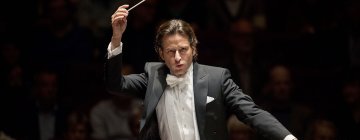Nestled somewhere between impressionism and contemporary classical, ambient music is an atmospheric genre that has drawn in composers and producers from around the world since its early development in the 1970s. Edward Larry Gordon, better known as Laraaji, is among ambient music’s pioneers and will revisit his breakthrough 1980 album Ambient 3: Day of Radiance on Friday, Aug. 29, at The Freight.
“People remind me how much they love it,” Laraaji said of Day of Radiance’s place in his life. “Usually I just go free-flow improvisational at-the-moment in concert. But The Freight requested that it be a Day of Radiance set.”
Laraaji had already released two smaller albums, including one under his birth name, when he was busking on the zither in Manhattan’s Washington Square Park. In what has become a famous story, Brian Eno, the keyboardist and ambient music pioneer walked by and liked what he heard, sparking a collaboration. Eno produced Day of Radiance and included it in his four-part Ambient album series, which also contains his own seminal Ambient 1: Music for Airports (1978).
“They always grow,” Laraaji said of his Day of Radiance performances. “My internal spiritual practice externalizes through my performance wherever I am in the seasons of my unfolding, whether I need more space or I reach for more celestial, contemplative passages in my music. Or I include more feelings that I didn’t do in the earlier years.”
This includes emphasizing tension, which seems contradictory to the typically relaxing nature of ambient compositions and improvisations. But without tension, there’s no release, he learned.
“My role as an artist is to be mindful of the time in which I’m sharing my music. But chaos is a way to let go of a mind that’s overloaded with information and content,” he continued, speaking by phone from his home in Harlem. “So moving through chaos via my performance can provide listeners with a reflection of what may be going on in themselves given the time we’re living in. “I mean, I wouldn’t stay in chaos,” he clarified. “But to move through it, I find it feels healthier and can be medicinal.”
With a live setup that includes his trademark electric zither, acoustic piano and, if available, a gong, Laraaji is accustomed to performing for audiences who receive his music and spoken-word messages differently. For sound baths, patrons are often lying on the floor with their eyes closed. During standing concerts, attendees can dance with abandon. (One can expect thoughtful listening, perhaps done horizontally on the dance floor's "sound bathing space," and some actual dancing off to the side at the heralded venue in Berkeley’s Downtown Arts District.)
Born in Philadelphia in 1943, Laraaji moved to New Jersey with his family two years later and attended public schools and the Baptist church, he said. Attending Howard University’s College of Fine Arts on a mix of scholarship and government loan funding, he studied music and composition, thriving in the HBCU setting.
He joined the Kappa Alpha Psi fraternity and interacted with students from the engineering and medical schools as well as those studying theater, dance, and history. He enjoyed learning, performing and, perhaps equally importantly, partying, with its subsequent networking benefits — one of his classmates was the late Donny Hathaway, the legendary soul performer. “Being immersed in a culture of people of color from around the world, it was very inspiring,” he reflected.
“I also learned to feel less like a trespasser in music and composition,” he added. Composers from Ralph Vaughan Williams and Samuel Barber to Aaron Copland and Béla Bartók caught his ear, as did pianists such as Oscar Peterson, Ahmad Jamal, and Errol Garner.
As our half-hour interview came to a close, I asked whether Laraaji has any zither pupils or disciples to extend his legacy. “That’s the first time I’ve been asked that question,” he replied. “No, I don’t. Gee, I better get on the ball!
“But I have played with a lot of musicians who have been inspired to trust their spontaneous improvisation talent with more confidence.”

